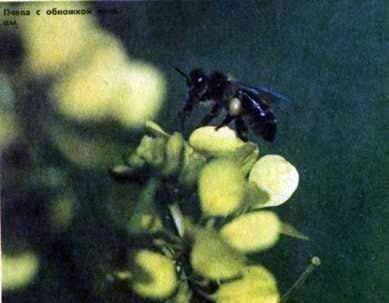
With each passing day new honey plants grow. Bees find more and more nectar for themselves. Tens of thousands of them are busy at this time pollen extraction.
In the nest appear oblong-oval lumps of pollen of various colors: bright yellow, dark brown, gray, light blue, as pitch black. Hence, many of the plant-blossom plants have already blossomed. Each pollen grain is a storehouse of nutrients. Here, proteins, fats, mineral salts, almost all vitamins. There is sugar and even antibiotics. In the pollen found 240 different substances.
In places where the pollen blossoms, bees bathe in pollen. Dust dust them from head to foot, stuffed between hairs. And the hairs of the bee are flat, like the feathers of a bird. Such their device helps bees to sweep the pollen off the flower stamens. Then the pickers of pollen with their brushes, which they have on their legs, like scallops, comb out of the hairs of a speck of dust and stuff them with their baskets. It is almost impossible to trace how quickly and skillfully all this is done.
The bulk of the pollen goes to feed the larvae, which can not develop without protein pollen. It is not by chance that the greatest number of broods occurs during the mass pollen harvest. The larva of the bee grows very fast. And not only because it is abundantly fed with bee milk, but also because it eats pollen, rich in hormones and growth substances that strengthen the body’s functions.
However, the pollen is not yet ready forage. This is a kind of flour, from which bees prepare their own bread. To connect the floral motes in a lump-rejuvenation, the bee wets it with saliva and nectar or honey. A ball of pollen, taken from the bee’s leg, does not disintegrate. In addition, the additives enrich the pollen, make it more nutritious.
After the assembler takes off the rejuvenation in the cell (this can be seen in the observation hive), other bees, their heads tightly ramming the pollen, add honey to it. Honey seems to ferment the pollen, and in the cell as in a bowl or a silo tower, it begins to wander. In a dense mass of pollen, fermentation takes place without oxygen. There is a processing of food with the help of microbes and enzymes, caught in this still rough food. As a result, a nourishing, easily digestible, useful product – perg is obtained. It is often called bee bread. The spicy aroma of pepper is reminiscent of the smell of a warm, freshly rye bread from the oven.
Perga is well preserved, even in winter it does not lose its valuable nutritional qualities. It is needed not only by the larvae, but also by the wetting bees, builders, and drone.
A bee family can collect up to 50 kg of this amazing food for spring and summer. For one flight, the bee brings 20-25 mg of pollen, and spends about 30 minutes on collecting it. It is not difficult to calculate what tremendous efforts of insects are laid in these puddles of harvested pollen.
It is very important to place the apiaries in spring in places where there are a lot of pollen plants. Young beekeepers can greatly enrich the melliferous flora. On the banks of small rivers, ponds, ravines, low damp places, around the school garden can be planted willow. To do this, cut the cuttings 5-10 cm thick and half a meter in length or slightly larger and stick them into the ground to a depth of 30 cm. These living rods receive enough moisture and nutrients from the soil, root, give shoots and grow quite rapidly.
A lot of nectar and pollen give maples and yellow acacia. They are not difficult to breed with seeds and seedlings. They are beautiful, decorative and very useful for bees. These unpretentious plants can be planted with streets, roads, planted on vegetable gardens, on slopes, lands unsuitable for plowing.
Пчела каменщица. Заменитель перги для пчел.
Young Beekeeper